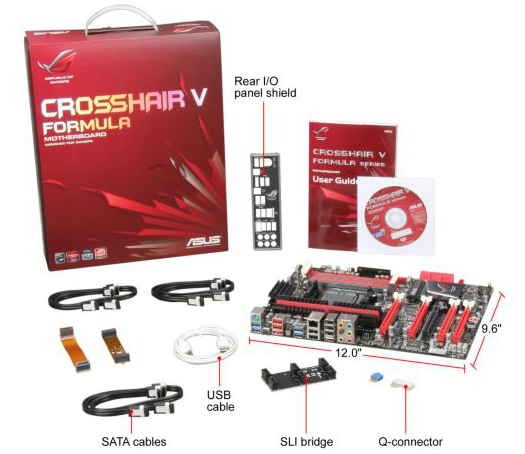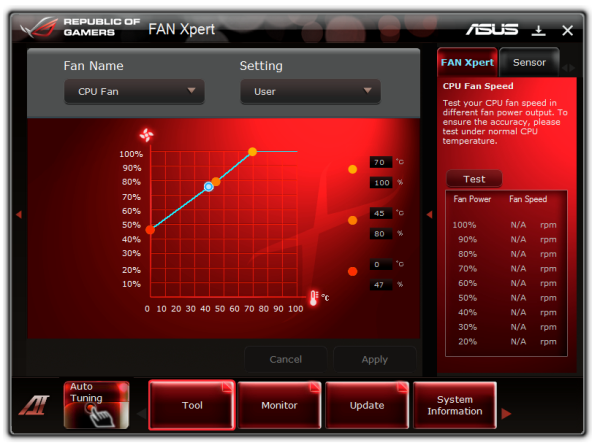990FX Motherboard Roundup with Thuban and Bulldozer – A Second Wind for ASUS, Gigabyte, MSI and Biostar
by Ian Cutress on April 5, 2012 11:00 AM ESTASUS Crosshair V Formula In The Box
For a top of the range Republic of Gamers’ motherboard, we all want goodies in the box. With the Crosshair V Formula, we get plenty of SATA cables and SLI connectors to fit the bill.
IO Shield
Driver CD
User Guide
Six SATA cables (locking, right angled)
Tri-SLI bridge
SLI bridge
Crossfire Cable
Q-Connectors

Image courtesy of Newegg
Board Features
| ASUS Crosshair V Formula (990FX) | |
| Price | Link to Newegg |
| Size | ATX |
| CPU Interface | AM3+ |
| CPU Support | AMD FX/Phenom II/Athlon II/Sempron 100 |
| Chipset | AMD 990FX |
| Base Clock Frequency | 200.7 MHz |
| Core Voltage | Auto, 0.675 V to 2.300 V |
| CPU Clock Multiplier | Auto, 4.0x to 39.5x |
| DRAM Voltage | Auto, 1.20 V to 2.90 V |
| DRAM Command Rate | Auto, 1T or 2T |
| Memory Slots |
Four DDR3 DIMM slots supporting up to 32 GB Up to Dual Channel Support for DDR3, 1066-2133 MHz, ECC or Non-ECC |
| Expansion Slots |
3 x PCIe Gen2 x16 (x16/x16 or x16/x8/x8) 1 x PCIe Gen2 x4 1 x PCIe Gen2 x1 1 x PCI |
| Onboard SATA/RAID |
6 x SATA 6 Gbps, Support for RAID 0, 1, 5, 10 1 x SATA 6 Gbps (ASMedia ASM1061) |
| Onboard |
7 x SATA 6 Gbps (6 Chipset, 1 Controller) 8 x Fan Headers 2 x USB 2.0 Headers 1 x USB 3.0 Headers 1 x S/PDIF Output Header 1 x Front Panel Header 8 x Measure Points 1 x Clear CMOS Header 1 x 4-pin Molex Connector Power/Reset Buttons OC / ROG Level Up Button 1 x Go Button |
| Onboard LAN | Intel 82583V |
| Onboard Audio | SupremeFX X-Fi 2 |
| Power Connectors |
1 x 24-pin ATX connector 1 x 8-pin 12V connector 1 x 4-pin 12V connector 1 x 4-pin Molex connector |
| Fan Headers |
2 x CPU Fan Headers (4-pin) 3 x CHA Fan Headers (4-pin) 3 x OPT Fan Headers (4-pin) |
| IO Panel |
1 x Keyboard/Mouse PS2 Port 1 x Clear CMOS Button 1 x Optical SPDIF Output 8 x USB 2.0 4 x USB 3.0 1 x eSATA 3 Gbps 1 x Gigabit Ethernet Audio Outputs |
| BIOS Version | 1003 |
| Warranty Period | 3 Years |
The ROG board is the only 990FX we are testing today to have an Intel network controller, a non-Realtek audio solution, and one of only two to support ECC memory according to the specifications.
Software
The bulk of ASUS’ software is always to be found in AI Suite, and in the land of ROG motherboards, we get a ROG specific skin. Also to hand is a ROG themed CPU-Z, in order to detect accurately the clock speed of the processor.
AI Suite II: As this software is now a few generations into the ASUS blood line, the effort from ASUS to have seamless integration and complete functionality is paramount. Needless to say, on the whole we are not disappointed. We have full control over the fans in the case through the Fan Xpert utility:
Overclocking through this utility is also part of the package. For users wanting a quick, permanent overclock, the Auto Tuning offers two modes labeled Fast and Extreme (see the overclocking section on the previous page to see the results of this on both Thuban and Bulldozer). For in operating system overclocking, users can proceed to the TurboV Evo section to select voltages, CPU ratios and base frequencies on the fly. These unfortunately are not permanent; however they do help overclockers find the limits of the system inside the OS so that when it comes to setting something stable in the BIOS, it is very easy to just plug in the correct values. I would like to see some options in TurboV Evo for ‘automatic’ voltages when applying overclocks (for those not wanting to touch voltage), and this idea has been planted into the ASUS hive mind as an option.
Stalwarts of the AI Suite are still available, such as DIGI+ VRM (primarily to give overclockers more headroom), EPU (energy saving), AI Charger+ (quick charging of Apple devices from specific USB ports), and ASUS update, which should make BIOS updating easier and simpler for a lot of users.
ROG CPU-Z: As mentioned, ASUS has collaborated with the makers of CPU-Z to get a ROG themed version, which allows users to verify their overclocks online, or check that the CPU or the memory is running as stated.

















57 Comments
View All Comments
IanCutress - Thursday, April 5, 2012 - link
Unfortunately we don't have an infinite amount of kit to review with. We're individual reviewers here, not all working in a big office. Obviously we can't all request top end kit from manufacturers either. Plus for every time we do use new high end kit, we also get comments about testing something 'more realistic' to most users. In that circumstance, we can't win and please everyone, but we do try and be as consistent as possible.Ian
phocean - Thursday, April 5, 2012 - link
I bought the Sabertooth a few weeks ago... and it throws an annoying buzzing sound in the speakers, especially when a USB port is used (in other words, all the time).It is the sign of an isolation issue between chipsets and shows poor design and testing from Asus.
Needless to say that the support was of no help (and no willing to help).
So don't buy it, unless you don't plug any speaker in it.
richaron - Friday, April 6, 2012 - link
Mine doesn't have this problem. You either got an unlucky board, or your psu is funky.extide - Thursday, April 5, 2012 - link
Seem to me like you were probably using a bit too much voltage for the BD. I would assume that is why you had so many issues with thermal runaway. 1.4-1.45ish would probably be a better place to stay with an air cooler :)extide - Thursday, April 5, 2012 - link
EDIT: Nevermind I forgot you are using the AMD kit watercooler, which is better than straight air cooling but I'd think it would take more of a fully custom built water setup to run 1.5v vCore.Hrel - Thursday, April 5, 2012 - link
I was going to build a new computer based on Ivy Bridge this Fall, I'm still running a Core 2 Duo E8400. But I've decided I'm not building myself a new computer until the motherboard has USB 3.0 and ONLY USB 3.0. A LOT of them, EVERYWHERE!I just built a guy a Z68 based computer with an i7 2700K but I had to order a VERY hard to find adapter card to plug in the USB 3.0 based memory card reader and the USB 3.0 on the front of the Fractal Design case. Because the Asus motherboard has ZERO USB 3.0 headers on it. It never even occurred to me that was a possibility. Not only has USB 3.0 been out for years now, but it was released WAY over-due. WTF is the hold up. Make the switch. USB 2.0 is for the 2000's decade, it's 2012. I am done with USB 2.0. I shouldn't have to buy an add-in card for BRAND NEW motherboard to support basic accesories, like a memory card reader and front usb port.
This is related to this article because I think if AMD was actually competitive with Intel AT ALL, like they were with Athlon XP/64/64 X2, then Intel would step up their game all around. Or maybe I wouldn't even have to buy Intel because they constantly make shit decisions like this, and changing the motherboard socket constantly, and charging 300 dollars for a quad core with HT. Their shit is endless and I really don't want to buy their products but AMD is simply not an option; if I wanted something that slow I'd just put a quad core Penryn based CPU in my current rig and save a bunch of money.
ggathagan - Friday, April 6, 2012 - link
There are only two Asus Z68 boards that don't have the USB 3 header, but somehow it's *Intel's* fault that Asus didn't use a USB 3 header on the board you bought?Huh...
Maybe you should have been a little more attentive when board shopping.
IanCutress - Friday, April 6, 2012 - link
Hi Hrel,I actually like USB 2.0 on my boards. If you have solely USB 3.0 and use them all, there's a big chance of a bottleneck in the bus somewhere. Also, I install a fresh operating system on every board I test via USB as it is a lot quicker than CD. Unfortunately during the install program, it doesn't process anything through the USB 3.0 ports - mouse, keyboard, or even the USB stick with the OS on. So I ideally like to have three USB 2.0 ports for that purpose. It's more a fault of Windows7 than the chipset, but otherwise if a board only has two USB 2.0 ports, I have to disconnect the mouse and use the keyboard and USB install drive only. Saying that, I have a board in that is solely USB 3.0, so it's going to be fun to install an OS on that... :/
Ian
fic2 - Friday, April 6, 2012 - link
I have a Dell keyboard that has 2 USB ports on it. That would solve your problem with a 2 x USB 2 mb. I currently have the mouse daisy chained off the keyboard.B - Thursday, April 5, 2012 - link
Your article should note that sound blaster provides a software overlay, but under that aluminum skin overlay lies a Realtek chip. I was fooled by this marketing and very disappointed after configuring this motherboard and discovering this fact. You don't get soudblasters hardware acceleration or the crystalizer. You should note this in any article about the asus line with x-fi2. Had I known I would have done things differently.